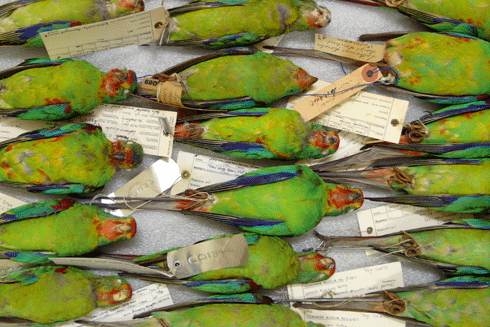
|
Published:
Can a parrot get justice under a Regional Forest Agreement?
Regional Forest Agreements (RFAs) and their ability to effectively protect endangered species, such as the swift parrot, have recently been the basis of a high profile legal action brought by Tasmania’s Senator Bob Brown. Now, two independent reports have found RFAs to be wanting.

|
|
Museum specimens of the critically endangered swift parrot, archived when the bird was more widespread. Credit: Kevin Leong
|
The swift parrot is a slender, green migratory bird with a long tail that breeds only in Tasmania. To reproduce, it needs to forage among abundantly flowering blue gums or black gums, close to old-growth trees with multiple hollows for nesting.
It is listed as endangered under the national Environmental Protection and Biodiversity Conservation Act 1999 (EPBC). Its population was thought to be stable at 1000 breeding pairs, but that has now been revised under an October 2008 review of its Tasmanian breeding habitat, taking the bird to ‘critically endangered’ status.
The key threat to the parrot is degradation of its habitat. Every year over 1000 hectares of suitable habitat forest in Tasmania are logged.
The EPBC Act is the law that protects endangered species in Australia, but regions covered by an RFA are exempt from the Act. The rationale is that a comprehensive assessment has already been undertaken to address the environmental, economic and social impacts of forestry in each RFA region.
But the worsening plight of the parrot highlights flaws in the RFA process.
In the case of Brown v Forestry Tasmania, Senator Brown sought to stop logging in Wielangta forest so as to protect three federally listed endangered species: the swift parrot, the Tasmanian wedge-tailed eagle and the Wielangta stag beetle.
Justice Marshall in the Federal Court found that logging in Wielangta would be likely to have a significant negative impact on all three species. He granted an injunction to stop logging and Forestry Tasmania was ordered to pay costs.
Following this decision, then Premier Paul Lennon and Prime Minister John Howard amended the wording of the RFA. Forestry Tasmania then appealed to the full bench of the court and was successful. Bob Brown was ordered to pay Forestry Tasmania’s costs, hence the $240 000 bill which was the prompt for a flood of public support in June this year.
The Full Court determined that the Tasmanian RFA did not require the state to protect the three threatened species. ‘Rather it is the establishment and maintenance of the CAR [Comprehensive, Adequate and Representative] reserves that constitutes the protection.’
Senator Brown then took the case to the High Court. The question he wanted to examine was whether there is an obligation for an RFA to act to protect a species, or whether it is sufficient simply to put a system in place whereby species theoretically receive protection.
Following the Howard–Lennon amendments in 2007, two judges thought that an appeal had insufficient prospect of success. In a 2:1 decision Brown was not granted leave to appeal.
This raises two alarming issues, firstly that there is no requirement for an RFA to provide any real protection for endangered species – the fact remains that in the Wielangta case the three species are not protected – and secondly, if there is such a requirement in an RFA, the prime minister and premier of a state are free to change the wording at will.
The Senate Environment Committee has since inquired into the operation of the EPBC Act and closely examined the Wielangta case. The majority report expressed concern that ‘neither transparency nor accountability’ are being adequately delivered, and it raised concerns that RFAs ‘afford a lesser level of protection than . . . the EPBC Act’.
The Environment Committee also emphasised that new information about the conservation status of rare species may not be translating into conservation actions.
The RFA process is also being closely examined in the independent review of the EPBC Act by Dr Allan Hawke, due to report at the end of October. His Interim Report argues that if the RFA exemption from the EPBC Act is to continue to apply for forestry operations there should be greater transparency, compliance with and enforcement of existing processes.
If environmental outcomes are not demonstrated appropriately, Hawke suggests there is a case for default provisions to re-assert the EPBC Act and override the RFA exemption. This recommendation will no doubt be the next subject of heated debate on this crucial issue of species protection in Australia.
More information:
EPBC Act,
www.environment.gov.au/epbc/index.html
Regional Forest Agreements,
www.daff.gov.au/rfa



